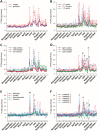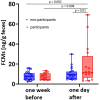Investigating the interplay of stressors and health in horses through fecal cortisol metabolite analysis
- PMID: 40264993
- PMCID: PMC12013657
- DOI: 10.3389/fvets.2025.1545577
Investigating the interplay of stressors and health in horses through fecal cortisol metabolite analysis
Abstract
Introduction: Horses are highly sensitive to stress, which can affect their wellbeing and lead to various health issues. Effective and objective stress assessment is therefore crucial for improving their care and management. The production of the glucocorticoid cortisol is increased in response to stressful stimuli and its metabolites can be measured non-invasively in feces. Therefore, this study aimed to explore the impact of different environmental and physiological stressors on fecal cortisol metabolite (FCM) concentrations in horses, with a particular focus on the relationship between stress, health, and welfare. We hypothesized that increased FCM levels may be indicative of disease and thus improve early detection and subsequent intervention.
Methods: Fresh fecal samples of N = 41 horses (20 geldings and 21 mares) from the same herd were collected once weekly for 1 year. Horses had been housed in the same stable for at least a month and were accustomed to the habitat, daily routine, and social groups. Environmental conditions, health data, and potentially stressful events were recorded. Fecal concentrations of 11,17-dioxoandrostanes were measured via 11-oxoetiocholanolone enzyme immunoassay.
Results: We showed stable baseline FCM concentrations of 6.3 ng/g feces (range 0.6-28.1 ng/g feces). During the summer months, median FCM concentrations increased significantly (p < 0.05; One Way RM ANOVA), and this increase correlated with higher ambient temperatures (p < 0.0001, adj r 2 = 0.669, Pearson Product Moment correlation). Additionally, other factors such as breed, coat color, and housing conditions influenced the FCM concentrations. Stressful events, such as riding exams and some painful conditions, also resulted in elevated FCM levels, although the magnitude of these responses varied across individual horses. However, not all diseases were associated with increased FCMs.
Discussion: Our findings emphasize the complexity of the hypothalamic-pituitary-adrenal axis in horses, suggesting that while high FCM levels can indicate stress, they may not be reliable biomarkers for early disease detection. Particularly in the light of climate change, the impact of heat stress in the summer months should not be neglected and measures to improve the housing conditions accordingly should become an essential part of equine health management.
Keywords: disease; glucocorticoids; heat; horse/equine; pain; stress.
Copyright © 2025 Nowak, Macho-Maschler, Biermann, Palme and Dengler.
Conflict of interest statement
The authors declare that the research was conducted in the absence of any commercial or financial relationships that could be construed as a potential conflict of interest.
Figures





Similar articles
-
Low plasma cortisol and fecal cortisol metabolite measures as indicators of compromised welfare in domestic horses (Equus caballus).PLoS One. 2017 Sep 8;12(9):e0182257. doi: 10.1371/journal.pone.0182257. eCollection 2017. PLoS One. 2017. PMID: 28886020 Free PMC article.
-
Effects of reproductive status and management on cortisol secretion and fertility of oestrous horse mares.Anim Reprod Sci. 2007 Dec;102(3-4):276-85. doi: 10.1016/j.anireprosci.2006.11.009. Epub 2006 Nov 19. Anim Reprod Sci. 2007. PMID: 17169515
-
Establishment of a non-invasive method for stress evaluation in farmed salmon based on direct fecal corticoid metabolites measurement.Fish Shellfish Immunol. 2017 Jul;66:317-324. doi: 10.1016/j.fsi.2017.04.012. Epub 2017 Apr 19. Fish Shellfish Immunol. 2017. PMID: 28433720
-
The contribution of total and free iodothyronines to welfare maintenance and management stress coping in Ruminants and Equines: Physiological ranges and reference values.Res Vet Sci. 2018 Jun;118:134-143. doi: 10.1016/j.rvsc.2018.01.025. Epub 2018 Feb 2. Res Vet Sci. 2018. PMID: 29428703 Review.
-
BEVA primary care clinical guidelines: Diagnosis and management of equine pituitary pars intermedia dysfunction.Equine Vet J. 2024 Mar;56(2):220-242. doi: 10.1111/evj.14009. Epub 2023 Oct 5. Equine Vet J. 2024. PMID: 37795557 Review.
Cited by
-
Fecal Cortisol Metabolites Indicate Increased Stress Levels in Horses During Breaking-In: A Pilot Study.Animals (Basel). 2025 Jun 7;15(12):1693. doi: 10.3390/ani15121693. Animals (Basel). 2025. PMID: 40564245 Free PMC article.
References
-
- Leal BB, Alves GE, Douglas RH, Bringel B, Young RJ, Haddad JPA, et al. . Cortisol circadian rhythm ratio: a simple method to detect stressed horses at higher risk of colic? J Equine Vet Sci. (2011) 31:188–90. 10.1016/j.jevs.2011.02.005 - DOI
-
- Keadle TL, Pourciau SS, Melrose PA, Kammerling SG, Horohov DW. Acute exercises stress modulates immune function in unfit horses. J Equine Vet Sci. (1993) 13:226–31. 10.1016/S0737-0806(06)81019-1 - DOI
LinkOut - more resources
Full Text Sources

